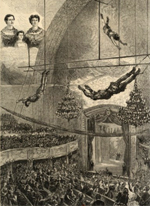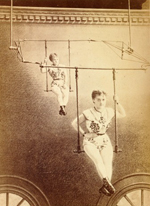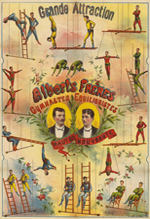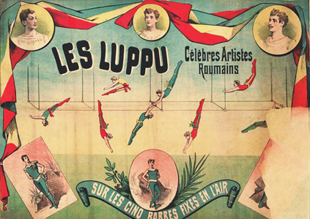by Magali Sizorn
Show logic invites permanent innovation. This innovation is seen in the increasing sophistication of physical techniques. It is also demonstrated in diverse propositions for aerial structures, original objects or composites.
The spectacular
Aerial structures often stem from an increasingly complex raft of possibilities offered by apparatus imported from gymnastics, in which multiple apparatus, and work on volume and trajectory appear. Imposing structures have been proposed in this way, mainly for the fixed bars. This apparatus, little used in the circus in its gymnastic form, is now used more frequently in combination with other apparatus, such as fixed bars, trapezes or aerial straps. The bar stands – as seen in the past at federal gymnastics fairs – squares composed of several fixed bars, and the spheres of hoops, stem from this cumulative process.
From the end of the 19th century, collective developments on the arrangement of bars were presented (aligned, parallel, or square bars). In the spaces thus constituted, acrobats performed rotations (suns and moons) and passages from one bar to another. In the 1870s, the Hanlon brothers combined the trapeze, flying trapeze and fixed bar in their act. In 1909, Edmond Rainat presented a "cross trapeze" act, with a structure composed of two flying trapezes: the aerial quadrille. This act, which combined different figures on the flying trapeze and the gymnastic apparatus on two perpendicular planes, was successfully developed after the First World War.
Unprecedented
New routines are particularly prized and “premieres” showered with praise in traditional circus rings. With this in mind, aerial acts often combine a search for originality and risk-taking. The routine performed by the Koch sisters in the 1940s was typical of this logic, whereby the spectacle lies in going further than anyone ever has before. The three sisters performed on a structure known as a semaphore that towered above the ring and rotated vertically. They would move around on top of the structure – as others would do in so-called “wheel of death” acts – walking along a horizontal balancing bar, or balancing as a trio on a bicycle and straps; one of the sisters would be suspended from the bike as her partners rolled across the semaphore.
More recently, the act performed by Misha Matorin, a graduate of the Moscow Circus School, offers an original meeting of the manipulation of objects and aerial routines. In the mid-1980s, he put together a routine that combined straps and an “aerial cube”, performed in several Cirque du Soleil shows (Alegria and Mystère), juggling with the twelve-edged object on the ground and in the air, playing with and in the space of the prism.
Unique
With the development of global shows, the contemporary circus has also seen the invention of architectural structures, of which Les Arts Sauts’ bubble housing a metal frame is one example. While a student at the CNAC in the mid-1990s (8th graduating class), Linet Andrea designed a piece of apparatus that allowed her to work alone, keeping installation constraints to a minimum and meeting her artistic aspirations. She sang, hung down, pulled herself up and landed on her “trapeze-pendulum”. In other settings, Mélissa Von Vepy was lifted off the ground by a giant industrial hook in Croc (2007), while in Infundibulum (2009), the acrobats of the Belgian company Feria Musica slid and slipped down a wooden funnel, a suspended swing-cum-slide that encouraged the audience to explore vertigo and the fun to be had in falling. These kinds of apparatus inspire the work of unique artists, often through specific and sometimes temporary constructions linked to particular creations or shows.











